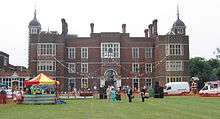Sir Adam Newton, 1st Baronet
Sir Adam Newton, 1st Baronet (died 1630) was a Scottish scholar, royal tutor, dean of Durham and baronet.
Life

He spent part of his early life in France, passing himself off as a priest and teaching at the college of St. Maixant in Poitou. There, for some time between 1580 and 1590, he instructed the future theologian André Rivet in Greek. After his return to Scotland he was, about 1600, appointed tutor to Prince Henry, and filled that post until 1610, when, upon the formation of a separate household for his pupil, now created Prince of Wales, he was appointed his secretary.
He was naturalized as an English citizen in James's first English parliament.[1] In 1605 he obtained the deanery of Durham through royal influence, although he was not in orders, and was installed by proxy. The duties of the office must also have been done by proxy, if at all. In 1606 he acquired the manor of Charlton, Kent, where he built Charlton House.
After the death of Prince Henry, in 1612, Newton became receiver-general, or treasurer in the household of Prince Charles, relinquishing to Thomas Murray his claim to the secretaryship. He retained his post until his death. In 1620 he was made a baronet, first selling the deanery of Durham to Dr. Richard Hunt, and presumably paying for his new honour with the proceeds. After Charles's accession Newton became secretary to the council, and in 1628 secretary to the marches of Wales, the reversion of which office had been granted to him as early as 1611; it was worth £2,000 year. He died 13 January 1630.
Works
Newton translated into Latin King James's Discourse against Vorstius and books i-vi. of Paolo Sarpi's History of the Council of Trent, which had been published in 1620 in London in an English version made from the Italian original by Sir Nathaniel Brent. Newton's translation was published anonymously in London in 1620. Thomas Smith complimented the work and man in his Vita quorumdam Eruditissimorum Virorum.
Family
In 1605 Newton married Katherine, youngest daughter of Sir John Puckering, lord-keeper of the great seal in the reign of Elizabeth, whose son Thomas Puckering shared the prince's studies under Newton's guidance; by her, who died in 1618, he was father of Henry, 3rd baronet.
Notes
References
![]() This article incorporates text from a publication now in the public domain: "Newton, Adam". Dictionary of National Biography. London: Smith, Elder & Co. 1885–1900.
This article incorporates text from a publication now in the public domain: "Newton, Adam". Dictionary of National Biography. London: Smith, Elder & Co. 1885–1900.